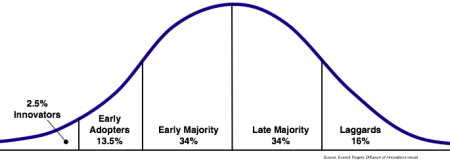While taking a short flight from Auckland to Queenstown, NZ I was thinking about the role of content as a tool of persuasion. Let me know what you think:
In every marketplace, when something new like technology comes along that requires a change in behavior, there’s a fairly predictable range of responses. Based on original research represented by Everett Rogers Technology Adoption Lifecycle that means: Innovators, Early Adopters, Early Majority, Late Majority and Laggards.

Image Credit: Wikipedia
I think there are some interesting implications for content and storytelling when it comes to influence on adoption of technology.
Let’s say you have an objective of persuading a group of potential customers to adopt a certain technology for marketing. One of the first steps is to profile those potential customers in terms of demographics and behaviors. A few key questions to be answered:
- What do they currently believe to be true?
- What are their objections to doing what you’ll be persuading them to do?
- What are their primary influences?
- What motivates their behaviors?
- What outcomes are most attractive to them?
- What would limit implementation, use and acceptance of your persuasion objective?
Profiling the target audience in this way can then be transformed into campaign efforts to persuade. One aspect of such a campaign would emphasize storytelling.
Highlighting and promoting stories that represent examples of persona archetypes making the transition from previous behaviors to the desired outcomes seems to me, a opportune method for persuasion with content. Those stories that are tailored specifically for the personas for each major segment of the target audience can provide the information and context needed to make fundamental changes in perception.
The narrative for each storyline would empathize with the current situation and provide reasonable and practical steps for overcoming objections and reasonable steps for making changes. Motivations for change can vary by persona, so its important to identify a content marketing strategy and structure that allows for such customizations.
The success stories of transition have to be real of course and also not appear so different that outcomes are not attainable.
I suspect the format for content in such a situation can run the gamut of text, digital, video, audio, images, events, email and so on. And you know me, if there’s content published digitally and online, it can be optimized for search and social.
Some possible phases of engagement with these stories and content for the purpose of our persuasion project:
- Content discovery – Word of mouth, advertising, search, social media, email
- Content engagement – Consumption and interaction: comments, questions
- Content comprehension – Internalizing what it means, visualizing the change in the context of their own situation. Seeing the possibilities.
- Content sharing – Word of mouth on/offline, social sharing, re-publishing, referrals
- Content internalization – Implementation of change in the individual behavior and organization
- Content enhancement – Building upon the original proposition and customizing, making it better, mashing it up
As stories are told, it makes sense to seek early success stories and creating a process for engaging with prospects, conversion, implementation and promoting successes. Such success stories can be small, tactical examples or more strategic and comprehensive. They can become the spokespeople for future growth, engagement and conversion.
Well, I’ve landed and have to say, writing on this new 11″ Macbook Air is a real pleasure. But I don’t want that or my impending adventure vacation to get in the way of an interesting discussion about content and storytelling as a platform for persuasion. Your comments are most welcome.
The applications for social psychology in online marketing are abundant and I don’t write about such things here, since the purpose of this blog is to be tactical and practical. But its inevitable that as the rate of innovation with search and social media increases, reaching the Late Majority and Laggards becomes more of a challenge. I’m always looking for ideas and creative solutions for such communications.


